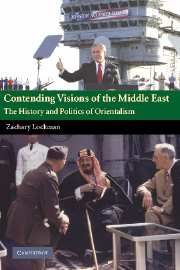Book contents
- Frontmatter
- Contents
- List of maps
- Acknowledgments
- 1 The rise of Islam and the Arab conquests
- 2 The Ottoman empire to 1566
- 3 The Middle East and North Africa on the eve of the First World War
- 4 The Middle East and North Africa between the Two World Wars
- 5 The Middle East and North Africa – boundaries
- 6 The Middle East and North Africa in the world
- Introduction
- 1 In the beginning
- 2 Islam, the West and the rest
- 3 Orientalism and empire
- 4 The American century
- 5 Turmoil in the field
- 6 Said's Orientalism: a book and its aftermath
- 7 After Orientalism?
- Afterword
- Notes
- Bibliography
- Index
4 - The American century
Published online by Cambridge University Press: 15 December 2009
- Frontmatter
- Contents
- List of maps
- Acknowledgments
- 1 The rise of Islam and the Arab conquests
- 2 The Ottoman empire to 1566
- 3 The Middle East and North Africa on the eve of the First World War
- 4 The Middle East and North Africa between the Two World Wars
- 5 The Middle East and North Africa – boundaries
- 6 The Middle East and North Africa in the world
- Introduction
- 1 In the beginning
- 2 Islam, the West and the rest
- 3 Orientalism and empire
- 4 The American century
- 5 Turmoil in the field
- 6 Said's Orientalism: a book and its aftermath
- 7 After Orientalism?
- Afterword
- Notes
- Bibliography
- Index
Summary
In the summer of 1914 the First World War broke out, pitting Germany, Austria-Hungary and (a few months later) the Ottoman empire against Britain, France and Russia, joined the following year by Italy and in 1917 by the United States. The war, which cost some ten million lives, resulted in the defeat and dismemberment of the Ottoman empire. After the war the victorious Allies, particularly Britain and France, proceeded to redraw the map of the Middle East and carve a number of new states – Iraq, Syria, Lebanon, Transjordan (later renamed Jordan) and Palestine – out of what had been the predominantly Arab provinces of the defunct Ottoman empire. Most of Palestine would become part of the new State of Israel in 1948, with the remainder falling under Jordanian or Egyptian control. But otherwise the states which Britain and France established in 1920–21 remain in existence today, their borders little changed. The war also helped set the stage for the conquest by the Sa'ud family and its allies of much of the Arabian peninsula and the creation in 1932 of the new Kingdom of Saudi Arabia, which a decade or so later would begin to develop strong ties with the United States (see Maps 4 and 5).
In Europe, the Allies largely fulfilled their wartime commitment to the right of subject peoples to national self-determination, and a number of newly independent nation-states – including Poland, Czechoslovakia, Hungary, Latvia, Lithuania and Estonia – came into being on territory that had previously been ruled by the Austro-Hungarian, Russian or German empires. But the British reneged on their wartime promise to support Arab independence.
- Type
- Chapter
- Information
- Contending Visions of the Middle EastThe History and Politics of Orientalism, pp. 99 - 147Publisher: Cambridge University PressPrint publication year: 2004

